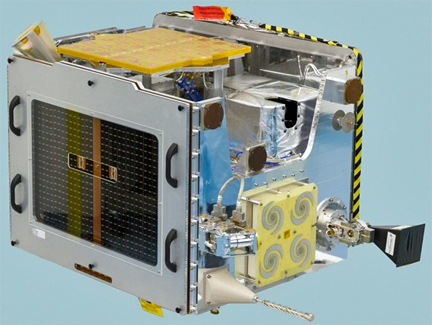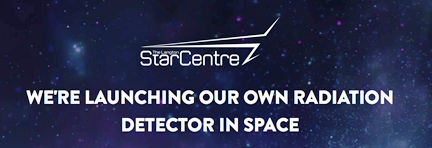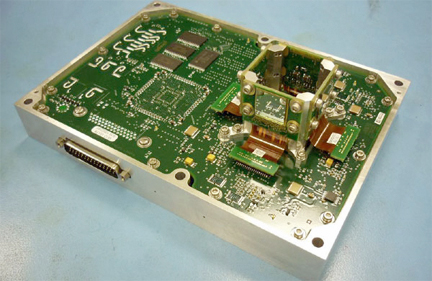
Photo of TechDemoSat-1.
Photo courtesy of Surrey Satellite Technology Ltd. (SSTL)
[SatNews In-Depth] A cosmic ray detector designed by sixth form students from the UK blasted off into orbit overnight aboard Surrey Satellite Technology Ltd.'s TechDemoSat-1.
Hundreds of schools across the United Kingdom will play a hands-on role analyzing vital 'space weather' data sent back to Earth by TechDemoSat-1, a UK-built satellite that started its journey into space overnight. TechDemoSat-1 is equipped with LUCID (Langton Ultimate Cosmic Ray Intensity Detector), a student-designed instrument which will collect information about the types, intensity and direction of cosmic rays that bombard satellites stationed around 635km above Earth, data crucial to ensuring that telecoms and other low-orbit satellites can withstand such radiation and function effectively.

Funded by the Science and Technology Facilities Council (STFC) the data from the project will be posted on the CERN@school (http://thelangtonstarcentre.org/) website where students across the country will be able to access it, scrutinize it and input their findings. These findings will then be made available to space experts around the world. Over 200 UK schools are expected to take up this unique opportunity to play a key part in serious science of global importance.

The data obtained from LUCID is of interest to the Space Weather community and NASA.
Photo courtesy of Langton Space Center.
LUCID is the brainchild of sixth-form students at Simon Langton Grammar School in Canterbury, Kent and has taken seven years to go from original concept to final lift-off. Pupils at the schools taking part in the project will be able to help sift the enormous volume of data produced by LUCID and pinpoint key features, trends and patterns. The aim is to fire them with enthusiasm for science and provide them with a launch pad for future careers in physics, engineering and other disciplines.The project is part of the CERN@school initiative. Supported by STFC and hosted at the Langton, CERN@school aims to assist the teaching of particle physics in the classroom by giving students the opportunity to analyse data from ground-based and space-based detectors.
STFC is also involved in other aspects of the TechDemoSat-1 mission including:
- Co-funding with the UK Space Agency on the establishment and operation of the UKube-1 ground segment. (planning and commanding) for the complex payload on UKube-1, and the running of the Ground Station at STFC's Chilbolton Observatory which is now communicating with the satellite
- STFC also sponsored an extended knowledge transfer partnership over 4 years between the University of Strathclyde and Clyde Space Ltd. for the development of the UKube-1 platform for all of the instruments
STFC RAL Space provided a novel electronics module to control the Compact Modular Sounder (CMS) instrument in a joint build with researchers from Oxford University.
The CMS uses infrared technology to create thermal maps of the surface of a Near Earth Asteroid. This will tell us about the rockiness of its surface, for example, where is a good place to land a robotic spacecraft, and how heating from the Sun and cooling in space can 'push' the asteroid around changing its orbit. While orbiting Earth, the mission will also take the opportunity to map surface temperature, including oceans, and the temperature structure of the atmosphere, with the view to compare this data with that from other Earth-observing instruments.
Professor Richard Holdaway, STFC's Director of RAL Space, said, "If the UK is to compete successfully in the global economy, we need a new generation of bright, motivated young scientists to step forward and keep driving research and industry to new heights. Participating in a real-life space mission with clear, comprehensible benefits is the perfect way of highlighting to young people the value, fascination and sense of achievement that a career in science and technology can deliver." Langton pupils came up with the idea for the LUCID detector following a trip in 2007 to CERN (the European Organization for Nuclear Research, home of the Large Hadron Collider). Having seen Timepix microchips developed there for particle physics, medical and other uses, they had a real 'eureka!' moment—realizing that the chips might be adapted to analyze charged particles in the 'solar wind' that streams from the Sun and sometimes disrupts satellite operations.
After entering the idea into a competition run by Surrey Satellite Technology Limited (SSTL) and the UK Space Agency, they worked with SSTL to develop it further with additional input from scientists worldwide. SSTL subsequently selected LUCID for inclusion as a payload on its TechDemoSat-1 satellite. Developed and built with support from the Technology Strategy Board and the South East England Development Agency (SEEDA), the satellite is providing low-cost flight opportunities for innovative commercial and research payloads developed by the UK space sector.
The launch of TechDemoSat-1 took place at Baikonur Cosmodrome in Kazakhstan, using a Russian Soyuz-2 rocket. LUCID will now undergo a month of in-flight testing prior to producing 'live' data over the course of a mission expected to last three years—a perfect illustration of how technology devised for the world's largest science experiments at CERN can be adapted to meet a range of real-world needs beyond the realm of particle physics.
Dr. Jonathan Eastwood, Lecturer in Space and Atmospheric Physics at Imperial College and an STFC Advanced Fellow, said, "LUCID isn't just an educational experiment. Its research-quality data will be of direct interest to the wider science community, allowing students to engage in real research, studying the basic physics of how space weather works."
The original six people in the LUCID team are now all doing research or working having finished their degrees. The current LUCID leader Matt Harrison said, "We are organized to process the data when it comes down to school. We have two full days of data collection in an eight day cycle, so we should see a huge number of frames where particles are detected by LUCID. We will be excited to be analyzing results and sharing this new data with the Space Weather community and with NASA."
The dedicated LUCID infosite is accessible via http://www.thelangtonstarcentre.org/lucid/

